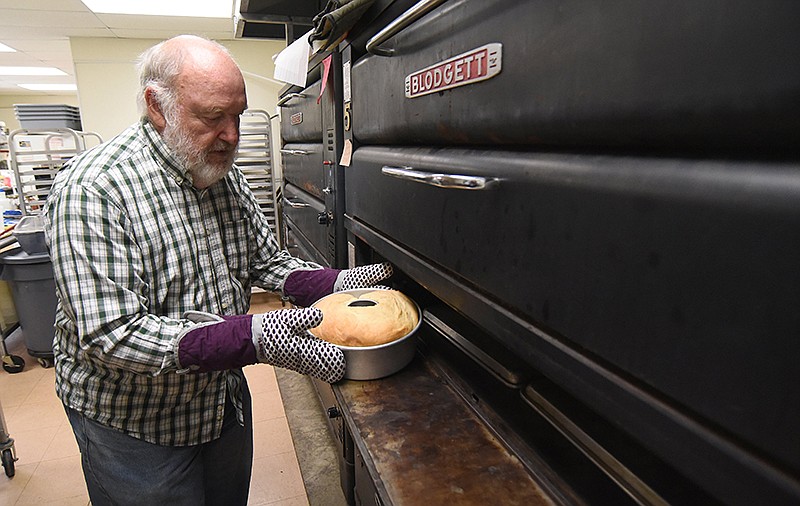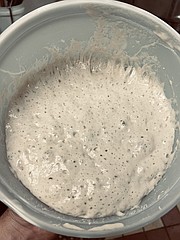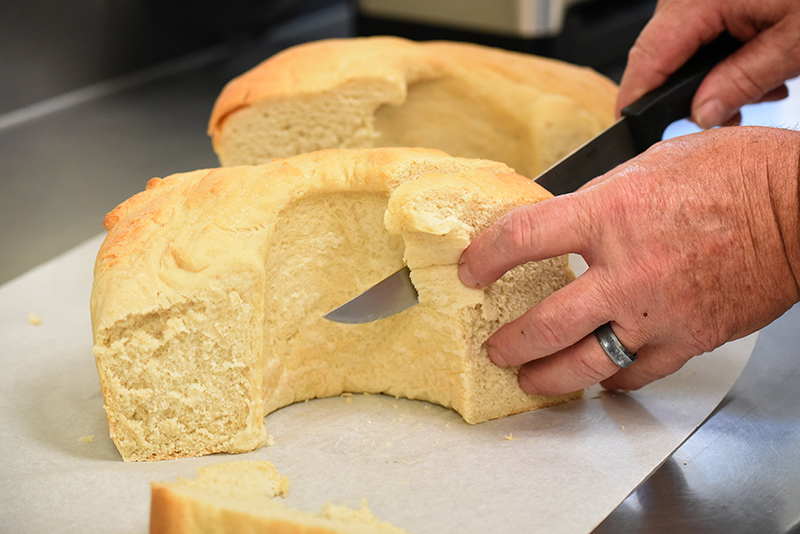When restaurants closed in the early days of the pandemic, many of us were forced to fend for ourselves in the kitchen. At first, we relearned the finer points of ramen noodles, grilled cheese sandwiches and other simple standards.
But after tiring of comfort foods on repeat - and having all those hours at home to watch Food Network - we turned our attention to more than mere sustenance. We began creating in the kitchen. Or at least making the attempt.
Bread was a biggie. For a time, yeast was hard to come by as cooks tested their baking skills to sate a different kind of hunger.
As PsychologicalScience.org explains: "In times of crisis, people covet creature comforts, and few things are as simple, yet satisfying, as freshly baked bread."
Even the professionals found solace in bread-baking. Today, they offer tips and a recipe for your next loaves.
The first time Dane Frazier, 35, tried his hand at baking, he was 11 or 12, he recalls, and forgot to include a key ingredient.
"I tried to make cookies before [my mom] got home [from work]," he says. "They were so liquidy. I had sheet trays full of oatmeal liquid. I forgot the flour.
"The face my mom made when she walked in the door was priceless," he remembers. But "she set her stuff down and we remade them. Baking is something I've always liked doing with my mom."
Those warm memories were part of the reason he chose baking as a course of study at the vocational high school he attended while living in the Lehigh Valley area of Pennsylvania during his teens. "I [also] liked the science of it," he says, then adds, "Maybe I should have been a welder."
It's a half-joking reference to how construction trades have fared better than the restaurant industry during the coronavirus pandemic.
During the worst of the economic downturn, Frazier was laid off from his job as pastry chef at St. John's Restaurant, a fine-dining destination in downtown Chattanooga. He took temporary jobs at Bluff View Bakery and the Red Bank Mojo Burrito before returning to St. John's, where he and his co-workers feel like "a nice, tight, little family," he says.
"I love the creative freedom they allow me to have," he says of the restaurant, where farm-to-table cuisine is a mainstay of the menu.
During the growing season, Frazier is a regular at local farmers markets, where he can peruse peaches, berries and other fresh ingredients for his sweet creations. A Facebook appeal helped him source harder-to-find fresh figs. A Red Bank couple with "five or six big trees" allows him to harvest the fruit in season. "They get to keep some, and I take the rest and sell them to the restaurant for salads and desserts," he says.
But the biggest baking advantage for this longtime pastry chef and baker is his sourdough starter. "She's named Samantha," he says. "She's my baby."
And he treats her as such, with plenty of discipline and tender loving care.
"Starters, just like children, like consistency," he says. "They like to be on a schedule. You get the best bread if you keep your feeding schedule consistent. You can't feed it erratically."
When Frazier has Samantha at home, he keeps her on the counter and feeds her once every other day. At work, where more is expected of her, he feeds her twice a day.
"I bring her out of the cooler every morning - you've got to bring her out and wake her up," he says. "She sits out eight hours or so while I make preferments for the following day's bread. Then I feed her and put her to bed."
Frazier says he shared his discards, part of the process of tending a sourdough starter, and doled out suggestions for friends who wanted to bake their own bread during the pandemic.
Frugal bakers might object to discarding what would appear to be perfectly good sourdough starter, but Frazier describes it as the biology of baking.
"When you feed her, you have to throw some away," he says. "Think about not having a bathroom in your house. You can't keep feeding and not have some waste."
Pro Tip
"When a recipe says 'room temperature,' they really mean it. They really do. And make sure you read the whole recipe and have everything you need before you start." - Dane Frazier
Dave Rhyne, 77, seems to be uncommonly suited to the agribusiness he and wife Vicki run in Athens, Tennessee. Sunshine Hollow is widely known for the abundance of flowers that grow in its sun and shade gardens, which are spread across 20 acres and visible from 8 miles of trails.
Rhyne's forestry degree and stint in the U.S. Army Corps of Engineers prepared him for the seasonal rotation of flowers, trees and other landscaping that need tending.
After weddings became a fixture on the picturesque grounds about 25 years ago, Rhyne added another skill to his can-do list: wedding cakes.
"After tasting some of the cakes that have come through here, I wanted to try to do a better product," he says.
He enrolled in cake decorating classes at the University of Tennessee at Knoxville and learned the finer points of crumb, piping and pillars.
He knows how to mix the cake to make it moist. "All the cakes I mix by hand to give it a good mouth feel," he says.
And you'll never catch him serving the commonly used frosting made of shortening and powered sugar. "I use real butter in mine," says Rhyne. "With a buttercream icing, you have an exceptional product."
The Maryville native says he learned to cook out of necessity during his bachelor days in college. His knack for it earned him the nickname "Mother Dave."
"Back in those days, you didn't have a lot of fast-food restaurants or things like that," Rhyne says. "I would have either starved to death or eaten peanut butter and jelly sandwiches all the time. I learned to cook to feed myself. As time has gone by, I've enjoyed cooking to feed friends and relatives."
During his military days, he began baking fruitcakes "out of the blue" so that he could give a handmade, heartfelt gift to combat the commercialization of Christmas. Rhyne recalls going through every recipe he could find in search of the perfect blend of ingredients and technique.
"The first few years, it was a hodgepodge of different things," he says of his fruitcake efforts. "Over the next 10 years, I refined all that down."
Vicki helped him hone the recipe once they were married. He's been mixing fruitcakes by hand since 1968, and using his final perfected recipe for more than 30 years. He sees no reason to change. "I make one of the best recipes that exists," he says.
It's not bragging if he can back it up. Fruitcake in general may get a bad rap, but at Sunshine Hollow, Rhyne's Pecan Fruitcake, bursting with pecans, cherries and pineapple, is the top-seller.
Over the last year, he's been baking more bread to gift to family and friends and to put the commercial kitchen to use during its normal summer downtime.
"I just decided it would be nice, since everybody was staying home, to go ahead and do some bread and take it around to friends who live nearby," he says. "I wanted to let them know somebody out there cares about them."
Rather than loaf pans, Rhyne uses the tubular fruitcake pans, the equivalent of two good-size loaves, he says, but in ring form with a hole in the center. "You slice it around the sides," he says.
He prefers yeast to sourdough, finding it "quicker and easier."
Rhyne says he's not surprised by the return to bread-baking during the pandemic, and hopes it's a quarantine-induced hobby that people stay with. One taste of homemade bread should be enough persuasion.
"It's hard to believe that people eat dry slices of bread out of the package," he says. "They've given up the taste and texture of real homemade bread for convenience."
Pro Tip
"Probably the most critical thing about bread-baking is having the water in the bowl at the right temperature. The mistake most people make is having their bowl at room temperature, around 70 degrees, then when you add the 2 cups of lukewarm water, the temperature of the bowl is going to drop the temperature of the water. Instead, put the bowl under hot water to get it warm. If you don't have your water set at the right temperature, it won't activate the yeast properly." - Dave Rhyne
Dave Rhyne's Yeast Bread
What you need:
1 tablespoon active dry yeast (1 package)
1 tablespoon granulated sugar
1 tablespoon salt
2 cups lukewarm water (105 Fahrenheit; will feel slightly warm to the touch)
5-6 cups all-purpose flour
What you do:
1. (Important!) Run hot water into the bowl you are going to use for mixing, and drain water.
2. Pour in 2 cups lukewarm water. Add yeast, sugar and salt and stir to dissolve, 2 minutes.
3. Add flour a cup at a time, and stir to mix. If it is still very wet, add more flour, and start mixing and kneading with floured hands until flour is absorbed.
4. Turn out of bowl onto a lightly floured surface (add more flour as needed). Keeping your hands floured, work the dough with your knuckles until it becomes elastic and smooth, pressing the dough down to flatten, then folding it back toward you, turning and repeating, for 4-5 minutes.
5. Form a ball with dough and place into a lightly oiled bowl, turning over to coat all sides; then cover with a damp dishcloth. (I use olive oil, but Pam or cooking oil will work also.)
6. Put bowl of dough in a warm place to rise, such as on top of the fridge. Let rise for 1-2 hours, depending on how warm the room is.
7. Dump the risen dough from the bowl onto a floured surface and press down on it with your floured hands to remove gas bubbles. Spray baking pans with Pam, then cut dough in halves and shape them into a loaf shape and place in pans.
8. Brush the tops with olive oil (my preference) or with butter, Pam or other oils. Place in warm place again to let double in bulk, 30 minutes to 1 hour. Heat oven to 400 Fahrenheit before the loaves are finished rising the second time.
9. Bake until they are browned nicely on top, about 45 minutes. But always check after 30 minutes or so since all ovens don't cook the same.
10. Let loaves cool until they can be handled, then dump out on clean surface. After they are cool, they can be wrapped with aluminum foil to freeze or plastic wrap if you are going to eat right away.
"I enjoy mine sliced, buttered and toasted best," Rhyne says.


